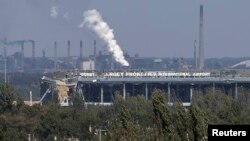While fighting in much of eastern Ukraine has been calmed by a month-old truce, it rages unabated at the airport near Donetsk, turning a shiny symbol of the country's Western integration into a shattered mirror of its future prospects.
The new terminal European soccer fans used in 2012 to reach some of the matches hosted by Ukraine is now a pitted hulk, a strategic target for the pro-Western Kyiv government and the rebels pulling the ex-Soviet republic back into Moscow's orbit.
The airport sits about 10 kilometers (six miles) from the city center. For the Ukrainian military, which wrested it from the rebels in fierce fighting in late May, it is their closest position to Donetsk, an industrial hub and separatist stronghold where the rebels declared a “people's republic” in April.
The separatists fear Kyiv troops may use the compound as a way into Donetsk.
“The airport is practically inside the city limits,” Eduard Basulin, a deputy defense minister in the “Donetsk People's Republic” (DNR), told Reuters.
“Our main goal is to push back the line from which they can shell us as far as possible so that they cannot fire at the city any more. They are very close,” Basulin said, his camouflage uniform decorated with a little silver-colored lapel pin depicting Soviet dictator Joseph Stalin.
The opposite kind of geopolitical symbolism was on display when Ukraine co-hosted the 2012 European soccer championship with European Union member Poland, another former communist country that is now a member of NATO.
But two years later, it was precisely Kyiv's Western aspirations that led to Moscow seizing Crimea in March and backing separatist claims in east Ukraine where turmoil erupted in April.
More than 3,500 people have since been killed, and the disintegration of the airport's terminal and control tower from heavy shelling is a striking symbol of the crumbling of the country and its prospects for closer ties with Western Europe.
Heavy weapons
Pro-Russian separatists now control large parts of the Donetsk region and that of Luhansk, a city in eastern Ukraine near the border with Russia where another separatist “people's republic” was declared.
The front line has moved little since the cease-fire early in September, although the rebels have gained a little more territory in Ukraine's southeastern corner and have their sights firmly set on the airport in Donetsk.
Ukraine's blue-and-yellow national flag is still tucked atop the airport's control tower where most windows are smashed, and military spokesman Andriy Lysenko said the runway was in working order. The rebels say the tarmac is badly damaged and cannot receive heavy transports.
“The flight runway at Donetsk airport is in satisfactory condition and can receive heavy planes which can deliver weapons and heavy military equipment,” Lysenko said on Monday, after rebels claimed most of the airport was under their control.
Ukrainian troops hold the building of the airport's old, smaller terminal whose solid basements offer enough shelter to sustain heavy shelling. A military compound sitting right next to the airport is also in Ukraine's hands.
There is daily skirmishing and regular outbursts of heavy fighting around the airport area and the military said its positions have come under attack from rebels in towns towards the Russian border such as Debaltseve and Shchastya that lie north-east of Donetsk.
On Monday afternoon, what looked like return fire from the military reached a residential area near the airport from which the rebels had fired on Ukrainian positions for a few days. The body of a local resident, wrapped in a carpet, lay on the ground nearby.
No ‘matter of hours’
The recapture in May of the airport, named after Donetsk-born composer Sergei Prokofiev and modernized with a glass and concrete terminal for the soccer tournament, marked an early triumph for President Petro Poroshenko.
The day after he was elected to replace a pro-Russian president ousted by protests in February, Ukraine launched airstrikes and a paratroop assault to retake the airport from rebels who had blocked it. A city morgue was filled with bodies of rebel gunmen after the battle.
Poroshenko at that time rejected any talks with “terrorists” and said a robust military campaign should be able to put down the revolt in “a matter of hours.”
But neither side has so far managed to get full control of the site and, more than four months later and despite the cease-fire that has led to a fall-off in fighting in many places in east Ukraine, Donetsk airport has seen little, if no respite.
Ukraine and the separatists both say they are respecting the cease-fire agreement and only replying to fire to protect themselves if attacked.
Both accuse the other of using multiple rocket launchers, heavy artillery and tanks in and around the airport perimeter, where hundreds of rival fighters have been killed.
Basulin said fewer than 200 separatists had been killed in the airport fighting, including more than 50 in late May on the first day of heavy clashes.
The bodies of some of them were taken to Russia for burial, fueling accusations by the government in Kyiv and its Western backers that Moscow is fanning the separatist unrest in the east by arming the rebels and reinforcing them with Russian troops.
Moscow said Kyiv has been mistreating the region's Russian-speaking population but denies direct involvement in a conflict that shows few signs of nearing a resolution.
With the rebels in Donetsk attacking the airport from the edge of the city, including from residential blocks and free-standing homes hit in the crossfire, many - but not all - residents left long ago.
